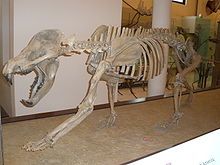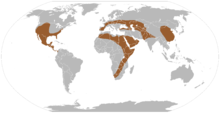Amphicyonidae
| Amphicyonids | |
|---|---|

| |
| Skeleton ofAmphicyon | |
| Scientific classification | |
| Domain: | Eukaryota |
| Kingdom: | Animalia |
| Phylum: | Chordata |
| Class: | Mammalia |
| Order: | Carnivora |
| Suborder: | Caniformia |
| Superfamily: | †Amphicyonoidea |
| Family: | †Amphicyonidae Haeckel,1866 |
| Subfamilies | |
|
†Amphicyoninae | |
Amphicyonidaeis anextinctfamilyofterrestrialcarnivoransbelonging to thesuborderCaniformia.They first appeared inNorth Americain the middleEocene(around 45 mya), spread toEuropeby the late Eocene (35 mya), and further spread toAsiaandAfricaby the earlyMiocene(23 mya). They had largely disappeared worldwide by the late Miocene (5 mya), with the latest recordedspeciesat the end of the Miocene in Africa. They were among the first carnivorans to evolve large body size. Amphicyonids are colloquially referred to as "bear-dogs".[1]
Taxonomy
[edit]
The family was erected by Haeckel in 1866 (also attributed to Trouessart 1885). Their exact position has long been disputed. Some early paleontologists defined them as members of the familyCanidae,but the modern consensus is that they form their own family. Some researchers have defined it as the sister clade to ursids (bears), based on morphological analysis of the ear region.[2][1]However, cladistic analysis and reclassification of several species of early carnivore as amphicyonids has strongly suggested that they may be basal caniforms, from lineages older than the origin of both bears and dogs.[3][4][5]
Description
[edit]Amphicyonids ranged in size from as small as 5 kg (11 lb) and as large as 100 to 773 kg (220 to 1,704 lb)[6]and evolved from wolf-like to bear-like body forms.[7]
Early amphicyonids, such asDaphoenodon,possessed adigitigradeposture and locomotion (walking on their toes), while many of the later and larger species wereplantigradeor semiplantigrade.[8]The amphicyonids wereobligate carnivores,unlike the Canidae, which arehypercarnivoresormesocarnivores.[9]
There is often some confusion with the similar looking (and similarly named) "dog-bears", a more derived group of caniforms that is sometimes classified as a family (Hemicyonidae), but is more often considered a primitive subfamily of ursids (Hemicyoninae).
Evolution
[edit]
It has long been uncertain where amphicyonids originated. It was thought that they may have crossed from Europe to North America during theMioceneepoch, but recent research suggests a possible North American origin from themiacidsMiacis cognitusandM. australis(now renamed as thegeneraGustafsoniaandAngelarctocyon,respectively). As these are of North American origin, but appear to be early amphicyonids, it may be that the Amphicyonidae actually originates in North America.[3]
Other New World amphicyonids include the oldest known amphicyonid,Daphoenus(37–16 Mya).
Amphicyonids began to decline in the late Miocene, and disappeared by the end of the epoch. The exact reasons for this are unclear. The most recent known amphicyonid remains are teeth known from theDhok Pathanhorizon, northernPakistan,dating to 7.4-5.3 mya.[10]The species is classically namedArctamphicyon lydekkeri,which may actually be synonymous with a species ofAmphicyon.[11]
Fossils of juvenileAgnotherium,Ischyrocyon,andMagericyonall show an unusual type of tooth eruption in which there is a vulnerable stage at about two or three years of age where the subadult animal has no functionalmolarorcarnassialteeth, the only functional cheek teeth being several milk premolars.[12]This period was suggested to be "presumably short" but would have made it very difficult for the animal to process food.[13]This type of tooth replacement is not seen in similar carnivorans likeursidsorcanids,and may have been one factor in the extinction of the Amphicyonidae.
Classification
[edit]Family Amphicyonidae
| Not assigned to a subfamily | SubfamilyAmphicyoninae | SubfamilyHaplocyoninae (Eurasia)[14][15] |
SubfamilyDaphoeninae (North America) |
SubfamilyTemnocyoninae (North America)[16] |
SubfamilyThaumastocyoninae[17] |
|---|---|---|---|---|---|
|
|
|
|
|
|
References
[edit]- ^abWang, Xiaoming and Richard H. Tedford (2008).Dogs; their Fossil Relatives and Evolutionary History.Columbia University Press. pp. 10–11.ISBN9780231135283.
- ^Hunt Jr., Robert M. (2001)."Small Oligocene Amphicyonids from North America (Paradaphoenus, Mammalia, Carnivora)".American Museum Novitates(3331): 1–20.doi:10.1206/0003-0082(2001)331<0001:SOAFNA>2.0.CO;2.ISSN0003-0082.S2CID198160461.Archivedfrom the original on 2023-09-04.Retrieved2023-07-06.
- ^abTomiya, Susumu; Tseng, Zhijie Jack (2016)."Whence the beardogs? Reappraisal of the Middle to Late Eocene 'Miacis' from Texas, USA, and the origin of Amphicyonidae (Mammalia, Carnivora)".Royal Society Open Science.3(10): 160518.Bibcode:2016RSOS....360518T.doi:10.1098/rsos.160518.PMC5098994.PMID27853569.Archivedfrom the original on 2016-10-14.Retrieved2016-10-13.
- ^Hunt, Robert M. Jr. (2004)."Global Climate and the Evolution of Large Mammalian Carnivores during the Later Cenozoic in North America"(PDF).Cenozoic Carnivores and Global Climate.pp. 139–285.doi:10.1206/0003-0090(2004)285<0139:C>2.0.CO;2.S2CID86236545.Archived fromthe original(PDF)on July 20, 2007.
{{cite book}}:|journal=ignored (help) - ^Morlo, Michael; Miller, Ellen R.; El-Barkooky, Ahmed N. (2007). "Creodonta and Carnivora from Wadi Moghra, Egypt".Journal of Vertebrate Paleontology.27(1): 145–159.doi:10.1671/0272-4634(2007)27[145:CACFWM]2.0.CO;2.ISSN0272-4634.S2CID86235694.
- ^Sorkin, B. 2008: A biomechanical constraint on body mass in terrestrial mammalian predators.Lethaia,Vol. 41, pp. 333–347.
- ^Jacobs, Louis L. Jacobs; Scott, Kathleen Marie: Evolution of Tertiary Mammals of North America: Terrestrial carnivores, Cambridge University Press, 1998
- ^Wang, Xiaoming and Tedford, Richard H. Dogs: Their Fossil Relatives and Evolutionary History. New York: Columbia University Press, 2008. p10-11, 29
- ^Hunt, R. M. Jr. (1998)."Amphicyonidae".In Janis, Christine M.; Scott, Kathleen M.; Jacobs, Louis L. (eds.).Evolution of Tertiary Mammals of North America, volume 1: Terrestrial carnivores, ungulates, and ungulatelike mammals.Cambridge, England: Cambridge University Press. pp. 196–227.ISBN978-0-521-35519-3.
- ^Sehgal, R. K. and A. C. Nanda (2002). "Age of the fossiliferous Siwalik sediments exposed in the vicinity of Nurpur, District Kangra, Himachal Pradesh".Current Science.82(4): 392–395.JSTOR24106648.
- ^Stéphane Peigné (2006). "A new amphicyonid (Mammalia, Carnivora, Amphicyonidae) from the late middle Miocene of northern Thailand and a review of the amphicyonine record in Asia".Thailand Journal of Asian Earth Sciences.26(5): 519–532.Bibcode:2006JAESc..26..519P.doi:10.1016/j.jseaes.2004.11.003.
- ^Morlo, Michael; Bastl, Katharina; Habersetzer, Jörg; Engel, Thomas; Lischewsky, Bastian; Lutz, Herbert; von Berg, Axel; Rabenstein, Renate; Nagel, Doris (3 September 2019). "The apex of amphicyonid hypercarnivory: solving the riddle of Agnotherium antiquum Kaup, 1833 (Mammalia, Carnivora)".Journal of Vertebrate Paleontology.39(5): e1705848.Bibcode:2019JVPal..39E5848M.doi:10.1080/02724634.2019.1705848.S2CID214431583.
- ^Morlo, Michael; Bastl, Katharina; Habersetzer, Jörg; Engel, Thomas; Lischewsky, Bastian; Lutz, Herbert; von Berg, Axel; Rabenstein, Renate; Nagel, Doris (3 September 2019). "The apex of amphicyonid hypercarnivory: solving the riddle of Agnotherium antiquum Kaup, 1833 (Mammalia, Carnivora)".Journal of Vertebrate Paleontology.39(5): e1705848.Bibcode:2019JVPal..39E5848M.doi:10.1080/02724634.2019.1705848.S2CID214431583.
- ^abJiangzuo, Q.; Wang, S.; et al. (September 2019). "New material ofGobicyon(Carnivora, Amphicyonidae, Haplocyoninae) from northern China and a review of Aktaucyonini evolution ".Papers in Palaeontology.7(1): 307–327.doi:10.1002/spp2.1283.S2CID204264754.
- ^Morales, J.; Abella, J.; et al. (May 2021)."Ammitocyon kainosgen. et sp. nov., a chimerical amphicyonid (Mammalia, Carnivora) from the late Miocene carnivore traps of Cerro de los Batallones (Madrid, Spain) ".Journal of Systematic Palaeontology.19(5): 393–415.doi:10.1080/14772019.2021.1910868.S2CID235363054.Archivedfrom the original on 2023-04-06.Retrieved2023-02-18.
- ^Hunt, Robert (2011-01-01)."Evolution of large carnivores during the mid-Cenozoic of North America: The Temnocyonine Radiation (Mammalia, Amphicyonidae)".Papers in the Earth and Atmospheric Sciences.Archivedfrom the original on 2023-03-26.Retrieved2023-04-07.
- ^Morales, J.; Fejfar, O.; Heizmann, E.; Wagner, J.; Valenciano, A.; Bella, J. (2019)."A new Thaumastocyoninae (Amphicyonidae, Carnivora) from the early Miocene of Tuchořice, the Czech Republic"(PDF).Fossil Imprint.75(3–4): 397–411.doi:10.2478/if-2019-0025.S2CID210921722.Archived(PDF)from the original on 2022-08-14.
- ^Berger, Jean-Pierre (June 1998). "'Rochette' (Upper Oligocene, Swiss Molasse): a strange example of a fossil assemblage ".Review of Palaeobotany and Palynology.101(1–4): 95–110.Bibcode:1998RPaPa.101...95B.doi:10.1016/S0034-6667(97)00071-7.
- ^abcdeFournier, Morgane; Ladevèze, Sadrine; Le Verger, Kévin; Fischer, Valentin; Speijer, Robert P.; Solé, Floréal (2020)."On the morphology of the astragalus and calcaneus of the amphicyonids (Carnivora, Mammalia) from the Paleogene of Europe: implications for the ecology of the European bear-dogs".Geodiversitas.42(18): 305–325.doi:10.5252/geodiversitas2020v42a18.S2CID220714559.
- ^Ginsburg, Léonard (2002). "Un Amphicyonidae (Carnivora, Mammalia) nouveau du Miocène moyen de Vieux-Collonges (Rhône)".Symbioses(in French).7:55–57.
- ^abcdPeign, Stphane; Salesa, Manuel J.; Antn, Mauricio; Morales, Jorge (2008)."A New Amphicyonine (Carnivora: Amphicyonidae) from the Upper Miocene of Batallones-1, Madrid, Spain".Palaeontology.51(4): 943–965.Bibcode:2008Palgy..51..943P.doi:10.1111/j.1475-4983.2008.00788.x.S2CID55334897.
- ^Solé, Floréal; Fischer, Valentin; Denayer, Julien; Speijer, Robert P.; Fournier, Morgane; Le Verger, Kévin; Ladevèze, Sandrine; Folie, Annelise; Smith, Thierry (2020)."The upper Eocene-Oligocene carnivorous mammals from the Quercy Phosphorites (France) housed in Belgian collections".Geologica Belgica.24(1–2): 1–16.doi:10.20341/gb.2020.006.S2CID224860287.
- ^de Bonis, Louis (2020)."New genus of amphicyonid carnivoran (Mammalia, Carnivora, Amphicyonidae) from the phosphorites of Quercy (France)".Fossil Imprint.76(1): 201–208.doi:10.37520/fi.2020.013.S2CID229196919.
- ^Wang, Xiaoming; Hong- gian g, Wang; Jiangzuo, Qigao (2016). "New record of a haplocyonine amphicyonid in early Miocene of Nei Mongol fills a long-suspected geographic hiatus".Vertebrata PalAsiatica.54(1): 21–35.
- ^Morales, Jorge; Pickford, M.; Valenciano, Alberto (2016)."Systematics of African Amphicyonidae, with descriptions of new material from Napak (Uganda) and Grillental (Namibia)".Journal of Iberian Geology.42(2): 131–150.doi:10.13039/501100003329.hdl:10261/137042.ISSN1698-6180.Archivedfrom the original on 2022-11-27.Retrieved2023-05-01.
- ^Grohé, Camille; de Bonis, Louis; Chaimanee, Yaowalak; Chavasseau, Olivier; Rugbumrung, Mana; Yamee, Chotima; Suraprasit, Kantapon; Gibert, Corentin; Surault, Jérôme; Blondel, Cécile; Jaeger, Jean-Jacques (2020)."The Late Middle Miocene Mae Moh Basin of Northern Thailand: The Richest Neogene Assemblage of Carnivora from Southeast Asia and a Paleobiogeographic Analysis of Miocene Asian Carnivorans".American Museum Novitates(3952): 1–57.doi:10.1206/3952.1.S2CID219296152.Archivedfrom the original on 2023-05-26.Retrieved2023-05-18.
- ^Werdelin, Lars; Simpson, Scott W. (2009)."The last amphicyonid (Mammalia, Carnivora) in Africa".Geodiversitas.31(4): 775–787.doi:10.5252/g2009n4a775.ISSN1280-9659.S2CID73677723.
- ^abcMorales, Jorge; Pickford, Martin (2022)."The taxonomic status of" Ysengrinia "ginsburgi Morales et al. 1998 (Amphicyonidae, Carnivora) from the basal middle Miocene of Arrisdrift, Namibia"(PDF).Communications of the Geological Survey of Namibia.24:1–16.Archived(PDF)from the original on 2023-04-05.Retrieved2023-05-01– via Google Scholar.
- ^Le Verger, Kévin; Solé, Floréal; Ladevèze, Sandrine (2020)."Description of a new species of Cynodictis Bravard & Pomel, 1850 (Carnivora, Mammalia) from the Quercy Phosphorites with comments on the use of skull morphology for phylogenetics"(PDF).Geodiversitas.42(16): 239–255.doi:10.5252/geodiversitas2020v42a16.S2CID220281575.Archived(PDF)from the original on 2023-09-04.Retrieved2023-07-06.
- ^Jiangzuo, Qigao; Li, Chunxiao; Wang, Shiqi; Sun, Danhui (2018-11-02)."Amphicyon zhanxiangi, sp. nov., a new amphicyonid (Mammalia, Carnivora) from northern China".Journal of Vertebrate Paleontology.38(6): e1539857.Bibcode:2018JVPal..38E9857J.doi:10.1080/02724634.2018.1539857.ISSN0272-4634.S2CID91998860.Archivedfrom the original on 2023-12-19.Retrieved2023-05-09.
- ^Werdelin, Lars (2019)."Middle Miocene Carnivora and Hyaenodonta from Fort Ternan, western Kenya".Geodiversitas.41(sp1): 267–283.doi:10.5252/geodiversitas2019v41a6.S2CID146620949.
- ^Morales, Jorge; Pickford, Martin (2022)."The taxonomic status of" Ysengrinia "ginsburgi Morales et al. 1998 (Amphicyonidae, Carnivora) from the basal middle Miocene of Arrisdrift, Namibia"(PDF).Communications of the Geological Survey of Namibia.24:1–16.Archived(PDF)from the original on 2023-04-05.Retrieved2023-05-01– via Google Scholar.
- ^Morales; Fejfar; Heizmann; Wagner; Valenciano; Abella (2021)."The Amphicyoninae (Amphicyonidae, Carnivora, Mammalia) Of The Early Miocene From Tuchořice, The Czech Republic".Fossil Imprint.77(1): 126–144.doi:10.37520/fi.2021.011.S2CID245032640.Archivedfrom the original on 2023-04-18.Retrieved2023-05-01.
- ^Fejfar, O.; Heizmann, E. (October 2015). "An illustrated summary of the lower Miocene carnivores (Mammalia, Carnivora) of Tuchořice, Czech Republic".Historical Biology.28(1–2): 316–329.doi:10.1080/08912963.2015.1029923.S2CID85904748.

